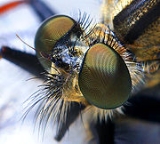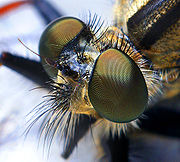
Asiloidea
Encyclopedia
Asiloidea is a very large cosmopolitan superfamily
of Diptera
. The former infraorder Asilomorpha
is paraphyletic and thus not a natural group; as its type taxon
the Asiloidea would still belong there in any case, but current knowledge of brachycera
n relationships would make it monotypic
: the Cyclorrhapha
appear to be the closest known relatives of the Asiloidea.
Though the ICZN
does not regulate taxa higher than superfamilies, two approaches to deal with the problem are possible: either the Asilomorpha are abandoned, and the Asiloidea are treated as a member of the basal (i.e. non-Cyclorrhapha) radiation of Brachycera. On the other hand, it might be even more practical to synonymize the Asiloidea with the Asilomorpha and place the asiloid families in the infraorder directly, following the example of the Tabanomorpha
.

An extinct family from the Mesozoic
are the Protapioceridae.
Taxonomic rank
In biological classification, rank is the level in a taxonomic hierarchy. Examples of taxonomic ranks are species, genus, family, and class. Each rank subsumes under it a number of less general categories...
of Diptera
Diptera
Diptera , or true flies, is the order of insects possessing only a single pair of wings on the mesothorax; the metathorax bears a pair of drumstick like structures called the halteres, the remnants of the hind wings. It is a large order, containing an estimated 240,000 species, although under half...
. The former infraorder Asilomorpha
Asilomorpha
The Brachyceran infraorder Asilomorpha is a large and diverse group of flies, containing the bulk of the non-muscoid Brachycera.The larvae of asilomorphs are extremely diverse in habits, as well.-Classification:...
is paraphyletic and thus not a natural group; as its type taxon
Taxon
|thumb|270px|[[African elephants]] form a widely-accepted taxon, the [[genus]] LoxodontaA taxon is a group of organisms, which a taxonomist adjudges to be a unit. Usually a taxon is given a name and a rank, although neither is a requirement...
the Asiloidea would still belong there in any case, but current knowledge of brachycera
Brachycera
Brachycera is a suborder of Diptera. It is a major suborder consisting of around 120 families. The most distinguishing characteristic of the suborder is reduced antenna segmentation...
n relationships would make it monotypic
Monotypic
In biology, a monotypic taxon is a taxonomic group with only one biological type. The term's usage differs slightly between botany and zoology. The term monotypic has a separate use in conservation biology, monotypic habitat, regarding species habitat conversion eliminating biodiversity and...
: the Cyclorrhapha
Cyclorrhapha
Cyclorrhapha is an unranked taxon within the infraorder Muscomorpha. They are called "Cyclorrhapha" with reference to the circular aperture through which the adult escapes the puparium...
appear to be the closest known relatives of the Asiloidea.
Though the ICZN
International Code of Zoological Nomenclature
The International Code of Zoological Nomenclature is a widely accepted convention in zoology that rules the formal scientific naming of organisms treated as animals...
does not regulate taxa higher than superfamilies, two approaches to deal with the problem are possible: either the Asilomorpha are abandoned, and the Asiloidea are treated as a member of the basal (i.e. non-Cyclorrhapha) radiation of Brachycera. On the other hand, it might be even more practical to synonymize the Asiloidea with the Asilomorpha and place the asiloid families in the infraorder directly, following the example of the Tabanomorpha
Tabanomorpha
The Brachyceran infraorder Tabanomorpha is a small group that consists primarily of two large families, the Tabanidae and Rhagionidae , and an assortment of very small affiliated families, most of which have been included within the Rhagionidae...
.

Families
Living families of Asiloidea are:- Apioceridae – flower-loving flies
- ApsilocephalidaeApsilocephalidaeApsilocephalidae is a family of flies in the superfamily Asiloidea. The family was proposed in 1991.Apsilocephalidae are close relatives of Therevidae distinguishable by genetalic characters.There are three living and two fossil species....
- ApystomyiidaeApystomyiidaeApystomyiidae are a family of flies. They are placed in the superfamily Asiloidea. There is only one genus which contains a single species....
- AsilidaeAsilidaeInsects in the Diptera family Asilidae are commonly called robber flies. The family Asilidae contains about 7,100 described species worldwide....
– robber flies - BombyliidaeBombyliidaeBombyliidae is a large family of flies with hundreds of genera, although their life cycles are not well known. Adults generally feed on nectar and pollen, thus are pollinators of flowers. They superficially resemble bees, thus are commonly called bee flies, and this may offer the adults some...
– bee flies - HilarimorphidaeHilarimorphidaeHilarimorphidae or Hilarimorphid flies are a Family of Diptera. They are placed in the Super family Asiloidea, though there is some considerable doubt, but the consensus is that they are most closely related to the Bombyliidae. Most species are nearctic....
- Mydidae – mydas flies
- MythicomyiidaeMythicomyiidaeMythicomyiids are very tiny flies found throughout most parts of the world, especially desert and semi-desert regions, except the highest altitudes and latitudes. They are not as common in the tropics, but genera such as Cephalodromia and Platypygus are known from these regions...
- EvocoidaeEvocoidaeEvocoidae is a Family of Diptera. They are placed in the Super family Asiloidea....
- Ocoa Flies - ScenopinidaeScenopinidaeScenopinidae or window flies are a small family of flies , distributed worldwide. In buildings they are often taken at windows, hence the common name window flies....
– window flies - TherevidaeTherevidaeTherevidae are a family of Diptera Asiloidea commonly known as stiletto flies. The family contains about 1,600 described species worldwide, most diverse in arid and semi-arid regions with sandy soils...
– stiletto flies
An extinct family from the Mesozoic
Mesozoic
The Mesozoic era is an interval of geological time from about 250 million years ago to about 65 million years ago. It is often referred to as the age of reptiles because reptiles, namely dinosaurs, were the dominant terrestrial and marine vertebrates of the time...
are the Protapioceridae.

